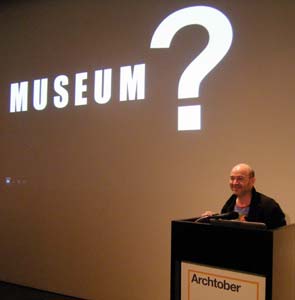by: Kristen Richards Hon. ASLA Hon. AIA
Event: Annual Arthur M. Rosenblatt Memorial Lecture – Being Alone Together: Managing the Museum as Mausoleum Syndrome
Location: Center for Architecture, 10.17.12
Speaker: Craig Dykers, AIA, Senior Partner, Snøhetta
Organizer: AIANY Cultural Facilities Committee
Noting that he is not a historian, Snøhetta Senior Partner Craig Dykers, AIA, proceeded to deliver an engaging, thoughtful, and often amusing description of “a somewhat hypothetical history of the museum” as the 6th Annual Arthur M. Rosenblatt Memorial Lecture. He speculated, using a sometimes ironic, sometimes humorous slide show, that “museums began not so long ago with the opening of the salons of the wealthy” to show off their collections of “exceptional objects.” As these patrons died, they were interred in “lavish and well-appointed” mausoleums. Subsequently, museums began to resemble the mausoleums, as if the artworks and artifacts were “mummified or embalmed” like their benefactors. Museums were “freezers for art” and status symbols for the well-to-do.
As the population grew in the industrial era, Dykers said, “people sought substitutes for museums in sideshows and travelling exhibitions, and themed museums became increasingly popular.” Spotlighting everything from science to dollhouses, they “could become a form of propaganda.” Not only that, “things could actually be sold in museums to all these people now visiting them”; museums themselves started to look like big-box retail stores and shopping malls, or “windowless, consumer-friendly art closets” in Dykers’ words.
The underground art movement begat experimental museums, where “social places and places for art were intertwined,” Dykers continued, which pressured traditional museums into becoming “after-hours party houses.” On the upside, the trend also saw the “simultaneous growth of the museum as an educational institution.” Added to the mix now is digital technology, and the idea of museum-as-spectacle. The “spectacular museum is among the most recent incarnations of the fetishistic container for art.” Even without art, Dykers posited, “they can change their urban conditions simply by virtue of their shape or color.”
In Dyker’s view, the definition of a museum “remains in a state of revision and redefinition” and that it’s time to “return power to the art rather than to its container.” He considers that, first and foremost, “a museum should not control the activities of those within,” but rather be a place for “unique thoughts shared at the same time – a place to be alone together.” As for his own definition for “museum”: “A place for art with people in it. A place for people with art in it.”
This was clearly evident in his whirlwind presentation of several of Snøhetta’s museum projects, from Norway and Denmark to Guadalajara and San Francisco, and, of course, the National September 11 Memorial Museum Pavilion at Ground Zero.
Kristen Richards, Hon. AIA, Hon. ASLA, is editor-in-chief of Oculus and ArchNewsNow.com.









